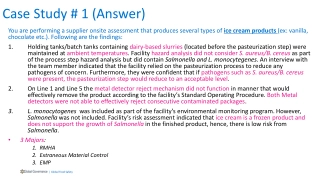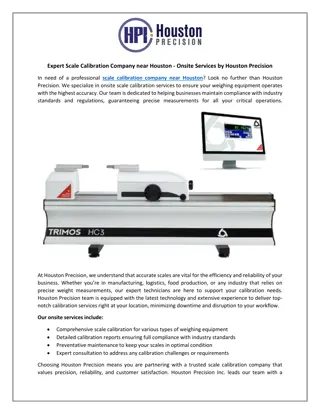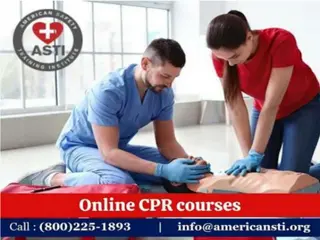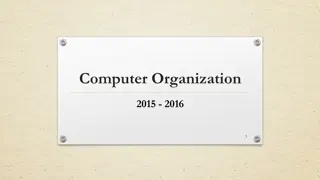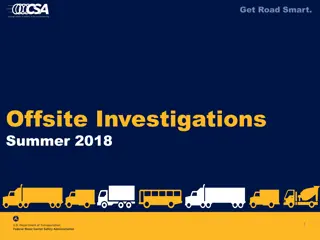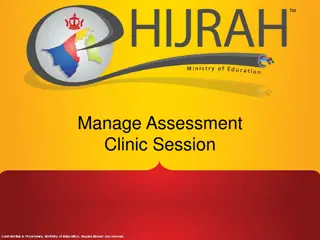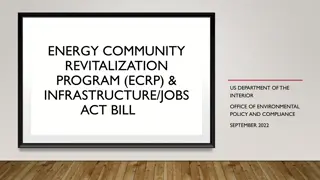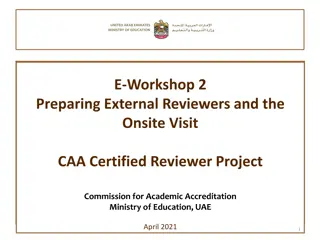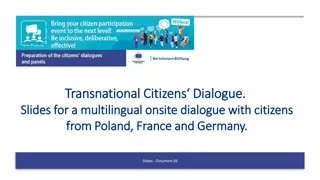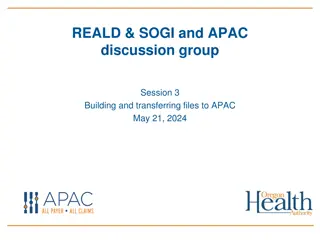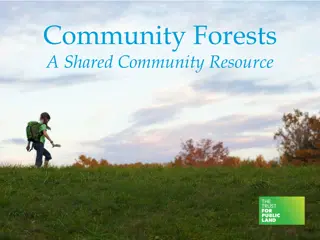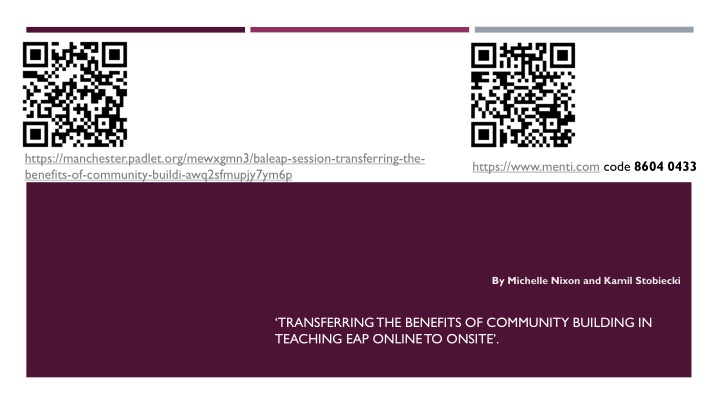
Exploring Community Building Strategies in EAP Teaching: A Case Study
Discover the impacts of community building in teaching English for Academic Purposes (EAP) through online and onsite courses. Explore strategies, research findings, and recommendations for fostering a sense of community among students and teachers in a dynamic learning environment.
Uploaded on | 0 Views
Download Presentation

Please find below an Image/Link to download the presentation.
The content on the website is provided AS IS for your information and personal use only. It may not be sold, licensed, or shared on other websites without obtaining consent from the author. If you encounter any issues during the download, it is possible that the publisher has removed the file from their server.
You are allowed to download the files provided on this website for personal or commercial use, subject to the condition that they are used lawfully. All files are the property of their respective owners.
The content on the website is provided AS IS for your information and personal use only. It may not be sold, licensed, or shared on other websites without obtaining consent from the author.
E N D
Presentation Transcript
https://manchester.padlet.org/mewxgmn3/baleap-session-transferring-the-https://manchester.padlet.org/mewxgmn3/baleap-session-transferring-the- benefits-of-community-buildi-awq2sfmupjy7ym6p https://www.menti.com code 8604 0433 By Michelle Nixon and Kamil Stobiecki TRANSFERRING THE BENEFITS OF COMMUNITY BUILDING IN TEACHING EAP ONLINE TO ONSITE .
ABSTRACT The recent pandemic has had a profound impact on EAP provision. Not unlike other universities, Manchester had to adapt and move courses online in both 2020 and 2021. Although the adaptation was undeniably successful in many ways, it came with certain costs to both students and teachers. This encouraged us to investigate the benefits of community building in teaching EAP online, specifically focusing on strategies that aid learning. We distributed questionnaires and conducted interviews with students, tutors and the course designer of the six-week pre-sessional course. The findings indicate that both students and tutors perceived community building as important and that the strategies that promote developing learners social presence (Garrison, Anderson & Archer, 2000) used on the course were seen as effective. Some of these include providing opportunities for students and teachers to get to know each other before the course and develop a sense of community further during the six weeks through completing a range of activities associated with using selected applications and websites. In 2022, we were able to return to the campus and deliver some of our pre-sessional courses onsite. Fortunately, it did not mean parting with the strategies that proved to be so important in previous years and most of the elements of the course that promote community building remained. While we are still investigating whether the students and tutors perceived them to be as important as those who had studied and taught entirely online, we would like to use the opportunity to lead a discussion on various aspects of course design and delivery among conference attendees. In addition, we would like the participants to share strategies for community building to give us information about the elements of online EAP teaching that are vital in the blended provision of the future. To achieve the above, we will use the key findings of our research as stimuli for discussion, followed by opportunities to share ideas through various applications and live polling. References: Garrison, D.R., Anderson, T. and Archer, W. (2000), Critical Inquiry in a Text-Based Environment: Computer Conferencing in Higher Education., The Internet and Higher Education, 2 (2-3), pp. 87-105 Stobiecki, K. and Nixon, M. (2022). The benefits of community building in teaching EAP online , Life online and beyond (EAP in the North event) University of Manchester 24th November 2021. Available at: https://www.baleap.org/wp-content/uploads/2021/05/EAP-in-the-North- abstracts-with-links-to-papers.pdf (Accessed: 29/09/2022)
OUTLINE Discussion context 1. 1.1 Theoretical background 1.2 The 2021 research context Selected findings and discussion: 2. 2.1 The value of getting to know each other 2.2 The value of sharing personal and study updates 2.3 The value of developing a sense of community further 2.4 The value of working in groups Conclusion and recommendations 3.
1.1 THEORETICAL BACKGROUND (Garrison et al., 2010, p. 6) (Garrison, 2009, p. 3)
1.1 THEORETICAL BACKGROUND Classroom community was defined as the connections among students and between students and instructors that lead to increased learning (Young and Bruce 2011, p. 220).
1.1 THEORETICAL BACKGROUND: THE BENEFITS A sense of community is central to student engagement and satisfaction. (Berry 2019, p. 164) Higher education has consistently viewed community as essential to support collaborative learning and discourse associated with higher levels of learning. (Garrison and Arbaugh 2007, p. 158) Student engagement and sense of classroom community are closely related to one another; students who feel a sense of connectedness rather than isolation are very likely better prepared to become more actively involved with course learning, successfully persist, and experience real world success. (Young and Bruce 2011, p. 227)
1.1 THEORETICAL BACKGROUND: THE STRATEGIES Online community can be improved by: decreasing the learners transactional space 1. Berry (2019, p. 164) identifies four strategies for building community online: increasing social presence 2. providing equal opportunity for involvement 1. reaching out to students often 3. designing small group activities 2. limiting time spent lecturing 4. facilitating group discussions 3. using video and chat as modes to engage students 5. matching teaching style with the learning stage 4. allowing class time to be used for personal and professional updates 6. limiting class size 7. (Rovai 2002, pp. 7-10)
1.2 THE 2021 RESEARCH CONTEXT Six-week pre-sessional online course at the University of Manchester Synchronous and asynchronous elements
1.2 THE 2021 RESEARCH CONTEXT: METHODS 1. Questionnaires distributed to approximately over 500 students with 147 responses 2. Questionnaires distributed to 47 tutors with 9 responses 3. A small focus group with 2 students 4. An interview with one of the course designers
2. SELECTED FINDINGS AND DISCUSSION PLEASE JOIN OUR PADLET TO ACCESS QUESTIONNAIRE LINKS AND OTHER RESOURCES
2. 1 The value of getting to know each other It's easier for students to learn after getting to know their class. Scan the QR code or click the link in our Padlet to answer this question. https://forms.office.com/e/i8xwzcg52R
2. 1 The value of getting to know each other: students perspective It's easier for me to learn after getting to know my class.
2. 1 The value of getting to know each other: tutors perspective It's easier for my students to learn after getting to know their class.
GROUP DISCUSSION 1 HOW CAN A TEACHER HELP STUDENTS TO GET TO KNOW THEIR CLASSMATES ONLINE AND ONSITE AT THE START OF A COURSE? DISCUSS YOUR VIEWS IN GROUPS (5 MINS.)
2.2 The value of sharing personal and study updates It s important that students are given time to get to know one another and share personal (and study) updates. Scan the QR code or click the link in our Padlet to answer this question. https://forms.office.com/e/meXftnN7eF
2.2 The value of sharing personal and study updates: students perspective It s important that our tutor gives us time to get to know one another and share personal (and study) updates.
3. The value of sharing personal and study updates: tutors perspective It s important that I give them time to get to know one another and share personal (and study) updates.
GROUP DISCUSSION 2 HOW CAN A TEACHER HELP STUDENTS TO SHARE UPDATES WITH THEIR CLASSMATES ONLINE AND ONSITE TO MAINTAIN COMMUNITY? DISCUSS YOUR VIEWS IN GROUPS (5 MINS.)
2.3 The value of developing a sense of community further - I think it s easier for students to learn in a class that feels connected. - Good rapport with the tutor and other students is important for course satisfaction. Scan the QR code or click the link in our Padlet to answer the questions. https://forms.office.com/e/NVebjywNVk
2.3 The value of developing a sense of community further: students perspective I think it s easier for me to learn in a class that feels connected.
2.3 The value of developing a sense of community further: students perspective Good rapport with the tutor and other students is important for my course satisfaction.
2.3 The value of developing a sense of community further: tutors perspective It s easier for my students to learn in a class that has a sense of togetherness.
GROUP DISCUSSION 3 HOW SHOULD THE SENSE OF COMMUNITY BE DEVELOPED FURTHER ONLINE AND ONSITE? DISCUSS YOUR VIEWS IN GROUPS (5 MINS.)
2.4 The value of working in groups - Completing tasks as a group helps students to learn more. - Working in breakout rooms in smaller groups helps students to feel more connected to the class. Scan the QR code or click the link in our Padlet to answer this question. https://forms.office.com/e/Kp5CBVuhKK
2.4 The value of working in groups: students perspective Completing tasks as a group helps me to learn more.
2.4The value of working in groups: students perspective Working in breakout rooms in smaller groups has helped me to feel more connected to the class.
2.4 The value of working in groups: tutors perspective Working in breakout rooms in smaller groups has helped my students to feel more connected to the class.
GROUP DISCUSSION 4 HOW CAN TUTORS FACILITATE GROUP-WORK ONLINE (BOTH SYNCHRONOUS AND ASYNCHRONOUS) AND ONSITE? DISCUSS YOUR VIEWS IN GROUPS (5 MINS.)
3. CONCLUSION AND RECOMMENDATIONS Our aim has been to share strategies for community building to give us information about the elements of online EAP teaching that are vital in the blended provision of the future. Why? In our context, a sense of community appears vital for student engagement and satisfaction (Berry, 2019). Community seems instrumental in supporting collaborative learning (Garrison and Arbaugh, 2007). Students who feel a sense of connectedness are likely to be more active and motivated in their learning (Young and Bruce, 2011).
3. CONCLUSION Getting to know other students is important. It is valuable to develop a sense of community further during the course. It appears that good rapport with the tutor and other students is important for course satisfaction. It seems vital to give students opportunities to share personal and study updates. Students value group work and perceive it as helpful to their learning. It is useful to give students opportunities to work in smaller groups. Using different tools for communication facilitates engagement and can have a positive influence on emotional wellbeing.
REFERENCES Berry, S. (2019). Teaching to connect: Community-building strategies for the virtual classroom. Online Learning, 23(1), 164- 183. http://dx.doi.org/10.24059/olj.v23i1.1425 Garrison, D. R., Anderson, T. & Archer, W. (2010). The first decade of the community of inquiry framework: A retrospective . The Internet and Higher Education, 13(1 2), 5-9. https://doi.org/10.1016/j.iheduc.2009.10.003 Garrison, D. R. (2009) Communities of Inquiry in Online Learning. Encyclopedia of Distance Learning, 352-355. https://doi.org10.4018/978-1-60566-198-8.ch052 Garrison, D.R. & Arbaugh, J. B. (2007) Researching the community of inquiry framework: Review, issues, and future directions . Internet and Higher Education 10 (2007), 157-172 Rovai, A. (2002). Building sense of community at a distance . International Review of Research in Open and Distance Learning, 3(1), 1-16. Young, S. & Bruce, M. A. (2011). Classroom Community and Student Engagement in Online Courses . MERLOT Journal of Online Learning and Teaching, 7 (2), 219 230.

